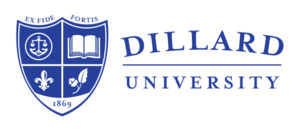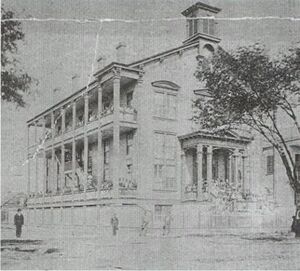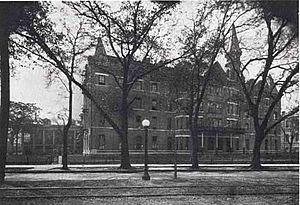Dillard University facts for kids
 |
|
|
Former names
|
Straight University (1868–1915) Straight College (1915–1930) Union Normal School (1868–1915) New Orleans University (1915–1930) |
|---|---|
| Motto | Ex Fide, Fortis |
|
Motto in English
|
"Strong Through Faith" (lit. "Out of faith, strong") |
| Type | Private historically black university |
|
Religious affiliation
|
United Church of Christ, United Methodist Church |
|
Academic affiliations
|
UNCF Space-grant |
| Endowment | $100 million |
| President | Monique Guillory |
| Provost | Eric Buckles (interim) |
| Students | 1,301 |
| Location |
New Orleans, Louisiana
,
U.S.
29°59′42″N 90°03′55″W / 29.99500°N 90.06528°W |
| Campus | Urban |
| Colors | Royal blue & white |
| Nickname | Bleu Devils and Lady Bleu Devils |
|
Sporting affiliations
|
NAIA – HBCUAC |
| Mascot | Bleu Devil |
Dillard University is a private university in New Orleans, Louisiana. It is known as a historically black university (HBCU). This means it was founded to educate African American students. The university started in 1930. It brought together older schools that began as early as 1869. Dillard University is connected with the United Church of Christ and the United Methodist Church.
University History
The story of Dillard University began in 1869. It started with two schools: Straight University and Union Normal School. These schools later became Straight College and New Orleans University.
Straight University's Beginnings
After the American Civil War, many formerly enslaved African Americans needed education. The American Missionary Association (AMA) helped with this need. They opened Straight University in New Orleans on June 12, 1868.
Straight University also taught professional skills. It had a law department from 1874 to 1886. Its graduates worked for civil rights during and after the Reconstruction era. In 1915, Straight University changed its name to Straight College. This name better showed what it taught.
Union Normal School and New Orleans University
The Union Normal School started on July 8, 1868. It was created by the Freedman's Aid Society of the Methodist Episcopal Church. Its main goal was to train teachers. The Society also found teachers in the North to work in the South. These teachers helped educate freed people and their children.
The AMA also helped start other historically black colleges and universities. These included Clark Atlanta University and Fisk University. Both Straight College and New Orleans University taught elementary teachers. But they quickly added more advanced classes. They offered high school, college, and professional training.
New Orleans University also ran a high school called Gilbert Academy. By the 1890s, it offered medical training. This included a pharmacy school and a medical college. It also had the Sarah Goodridge Hospital and a nurse training school. After the medical college closed in 1911, the Flint Goodridge Hospital continued nurse training.
Forming Dillard University: 1930–1935
| Will W. Alexander | 1935–1936 |
| William Stuart Nelson | 1936–1940 |
| Albert Walter Dent | 1941–1969 |
| Broadus Nathaniel Butler | 1969–1973 |
| Myron Wicke | 1973–1974 |
| Samuel DuBois Cook | 1974–1997 |
| Michael Lucius Lomax | 1997–2004 |
| Bettye Parker Smith | 2004–2005 |
| Marvalene Hughes | 2005–2011 |
| James E. Lyons, Sr. | 2011–2012 |
| Walter M. Kimbrough | 2012–2022 |
| Rochelle L. Ford | 2022–2024 |
Leaders in New Orleans wanted a bigger, more important university for African Americans. Because of money problems and talks between the two schools, Straight College and New Orleans University joined. They officially formed Dillard University on June 6, 1930.
The new university was named after James H. Dillard. It aimed to offer a traditional college education. It also wanted to work closely with the Black community. This was a challenging time due to the Jim Crow era. During this time, laws and customs kept Black and White people separate. Some local White people were concerned about a Black president leading White teachers. They also worried about more African American students riding buses in the area.
Edgar B. Stern Sr, a helpful member of Dillard's board, suggested Will W. Alexander as president. He was a White Southern preacher. He became Dillard's first acting president from 1935 to 1936. Dillard University opened in the fall of 1935. It attracted important scholars. These included Horace Mann Bond and St. Clair Drake.
Dillard in the 21st Century
In 2003, the famous musician Ray Charles left money in his will. He gave $1 million to Dillard to create a special teaching position. This position focuses on African-American cooking history. It was the first of its kind in the country. It is called the Ray Charles Program.
In August 2005, Hurricane Katrina caused a lot of damage. The campus was flooded. One building, Nelson Hall, was destroyed by fire. A bus fire also ruined the belongings of 37 students who were leaving.
In spring 2006, Dillard students took classes in other locations. They used The New Orleans World Trade Center and a hotel. Dillard still held its graduation ceremony on campus in July 2006. Students were able to return to campus in September 2006.
In November 2016, a media company held a debate at Dillard University. It featured political candidates. Some people protested the event, and six protesters were arrested. The university had agreed to host the debate months before. At that time, they did not know who the candidates would be.
In 2019, Dillard partnered with Ross University School of Medicine. This partnership aims to increase the number of African American doctors in the U.S. In 2020, MacKenzie Scott donated $5 million to Dillard University. This was the largest single gift in the university's history.
Academic Programs
| USNWR Liberal Arts College | RNP |
|---|---|
| Washington Monthly Liberal Arts | 83 |
Dillard University offers many different degrees. Students can earn Bachelor of Arts, Bachelor of Science, and Bachelor of Science in Nursing degrees. There are over 35 main subjects to study. These subjects are part of four main academic colleges. Each college has different departments.
Student Research Opportunities
Dillard University is part of groups that support student research. Most departments offer classes on how to do research. The university's Office of Undergraduate Research also holds workshops. These workshops teach students how to write proposals and analyze information.
Students can join special research projects. They can also enter the Undergraduate Research & Creative Work Competition. The university also publishes a journal. It is called the Dillard University Journal of Undergraduate Research (DUJOUR). It shares the findings of student research projects.
Institute of Jazz Culture
The Institute of Jazz Culture (IOJC) started in 2002. It was founded by Irvin Mayfield. The institute connects community, jazz music, and education. It creates lessons and programs for college and high school students.
Dual Degree Programs
Dillard has special programs called dual degrees. These programs let students earn two degrees from two different schools. Dillard partners with universities like Louisiana State University and Tulane University.
University Athletics
Dillard's sports teams are called the Bleu Devils and Lady Bleu Devils. The university is part of the National Association of Intercollegiate Athletics (NAIA). They mainly compete in the HBCU Athletic Conference (HBCUAC). This conference was formerly known as the Gulf Coast Athletic Conference (GCAC). Dillard has been a member since the 1981–82 school year.
Dillard has 12 different sports teams. Men's sports include baseball, basketball, and tennis. Women's sports include basketball, volleyball, and track & field. Cheerleading and dance are co-ed sports.
Sports Facilities
The Dillard basketball and volleyball teams play at Dent Hall.
Campus Life
Dillard University's campus is about 55 acres. It is in the Gentilly neighborhood of New Orleans. The campus has beautiful buildings with a classic style. It also has many old oak trees. A double row of trees, called the "Avenue of the Oaks," is a main feature of the campus.
Academic Buildings
- DUICEF (Dillard University International Center for Economic Freedom) opened in 2004. It has offices for education and psychology. It also has computer and language labs.
- Howard House, built in 1936, was once a guest house. Now, it is home to the business program. It is named after Alvin Pike Howard, a successful businessman.
- The Professional Schools Building is the newest academic building. It opened in 2010. This building has programs for business, nursing, and public health. It also has science, technology, engineering, and math departments.
- Rosenwald Hall was Dillard's first permanent building, built in 1934. It was originally the campus library. It is named after philanthropist Julius Rosenwald. This building now holds the university's main offices. It was damaged by Hurricane Katrina but has since reopened.
- Samuel DuBois Cook Fine Arts and Communications Center was built in 1993. It is named after Dillard's sixth president, Samuel DuBois Cook. This building has art galleries, TV and recording studios. It also has music and drama departments, a theater, and a radio station.
- Stern Hall is Dillard's science building, built in 1952. It is named after Edgar Bloom Stern, a well-known financier. This building has labs for nursing, natural sciences, biology, chemistry, and physics. It also has two computer labs.
Athletic Facilities
- Dent Hall is the university's gymnasium. It was built in 1969. It is named after Albert W. Dent, the university's third president. Dent Hall is where the basketball teams play. It also has offices, classrooms, a dance studio, and a swimming pool.
- Henson Hall is Dillard University's old gymnasium. It was built in 1950. It is named after Matthew Alexander Henson, an explorer. He was the first African American to reach the North Pole. Henson Hall now houses the university's bookstore and a temporary library.
Library
- Will W. Alexander Library is Dillard University's library. It was built in 1961. It is named after Will W. Alexander, the first acting president. The library has many books, journals, and historical documents. It was damaged by Hurricane Katrina but reopened in April 2008.
Chapel
- Lawless Memorial Chapel was built in 1955. It is named after Alfred Lawless Jr. and his son Theodore K. Lawless. Now called Lawless Assembly Hall, it was the only building on campus not damaged by Hurricane Katrina.
On-Campus Housing
- Camphor Hall is a female dormitory, built in 1947. It is named after Bishop Alexander Priestly Camphor. This dorm is connected to Hartzell Hall.
- Hartzell Hall is a dormitory, built in 1935. It is named after Joseph Crane Hartzell, a missionary bishop. It reopened in the fall of 2013. This dorm is connected to Camphor Hall.
- Straight Hall is a dormitory, built in 1936. It is named after Seymour Straight, a leader of Straight College. It reopened in the spring of 2013.
- Williams Hall is a female dormitory. It is named after Fannie C. Williams, an educator. It became a co-ed dorm in 2014.
- Gentilly Gardens offers apartment-style housing on campus. These apartments are for junior and senior students.
- Nelson Complex had three buildings for student housing. It was named after William Nelson, the first African American president. It was destroyed by fire during Hurricane Katrina.
Student Center
- Kearny Hall is the student center. It was built in 1935. It is named after Warren Kearny, a university trustee. Kearny Hall is in the middle of campus. It has a lounge, post office, and cafeteria. The cafeteria was updated in 2019.
President's House
The president's residence was built in 1936. It has been home to six of Dillard University's presidents. It now serves as the Alumni House.
Famous Alumni
Many notable people have attended Dillard University, Straight University, or New Orleans University. Here are a few:
| Name | Class year | Notability | |
|---|---|---|---|
| James W. Ames | 1882 | Founder of Dunbar Hospital, the first Black hospital in Detroit, MI | |
| Harold Battiste Jr. | 1952 | Jazz musician and composer; worked with many famous artists | |
| John W. E. Bowen Sr. | 1878 | One of the first African Americans to earn a PhD | |
| Napoleon Bracy Jr. | 2000 | A member of the Alabama House of Representatives | |
| Jericho Brown | 1998 | An award-winning poet | |
| Winifred Burks-Houck | An environmental chemist and the first female president of NOBCChE | ||
| Sherman Copelin | 1965 | A member of the Louisiana House of Representatives | |
| Dave Dennis | 1968 | A civil rights activist | |
| Roger Donald Dickerson | 1955 | A pianist and composer | |
| W. T. Handy, Jr. | 1948 | A Bishop in the United Methodist Church | |
| Patrick O. Jefferson | 1990 | A member of the Louisiana House of Representatives | |
| Kimberly S. Johnson | A Professor of Medicine at Duke University | ||
| Ernest Lyon | 1888 | A minister and former United States Ambassador to Liberia | |
| Ellis Marsalis Jr. | 1955 | A jazz pianist and music teacher; father of several jazz artists | |
| Orelia Merchant | 1992 | A federal judge since 2023 | |
| Garrett Morris | 1958 | A comedian and actor from shows like Saturday Night Live | |
| Khalid Abdul Muhammad | 1970 | A national spokesman for the Nation of Islam | |
| Alice Dunbar Nelson | 1892 | A Women's rights activist, poet, and author | |
| Alfred Lloyd Norris | 1960 | A Bishop in the United Methodist Church | |
| Revius Ortique Jr. | 1947 | The first African American to serve on the Louisiana State Supreme Court | |
| Brenda Marie Osbey | 1978 | The Poet Laureate of Louisiana | |
| P.B.S. Pinchback | 1885 | The first African-American governor in the United States | |
| Renée Gill Pratt | A local New Orleans politician | ||
| Beah Richards | 1948 | An actress, poet, and playwright | |
| Joyce M. Roche | 1970 | President and CEO of Girls, Inc. | |
| Ruth J. Simmons | 1967 | The first African-American president of an Ivy League University | |
| Carl E. Stewart | 1971 | A judge for the U.S. Fifth Circuit Court of Appeals | |
| Jimmy Womack | 1976 | A minister and member of the Michigan House of Representatives |




